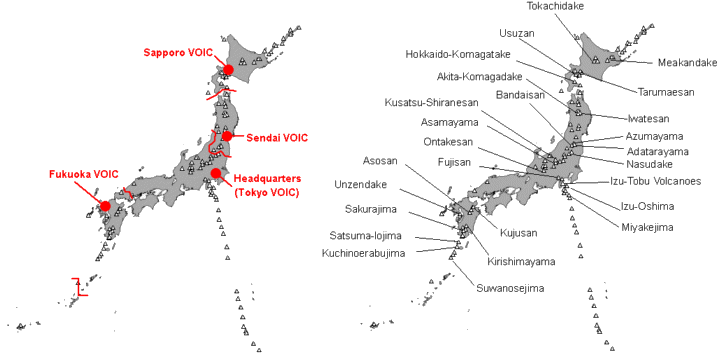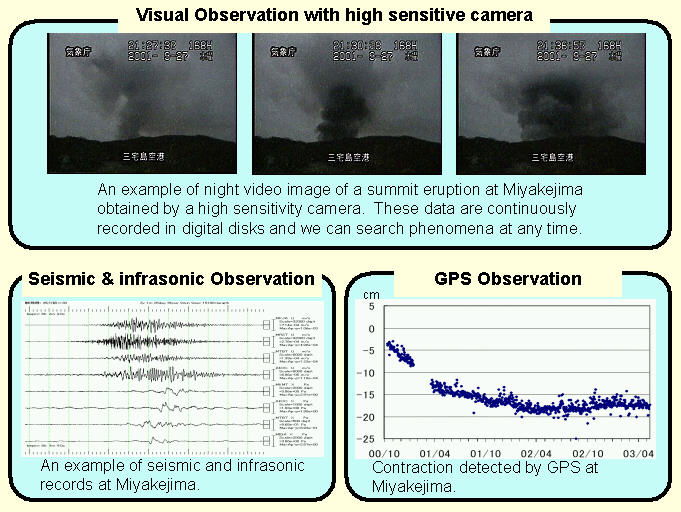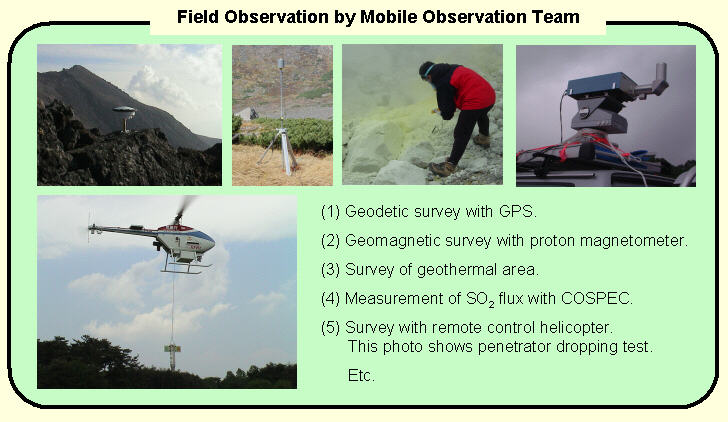|

There are currently a total of 108 active volcanoes in Japan. Eruption or abnormal phenomena are observed approximately at 10 volcanoes a year on average, sometimes causing great disasters. The Japan Meteorological Agency has defined active volcanoes in Japan as "volcanoes which have erupted within 10,000 years or volcanoes with vigorous fumarolic activity".
Japan Meteorological Agency (JMA) has the responsibility to release Volcano Information if distinctive volcanic activities are taken place from disaster mitigation point of view.
JMA continuously monitors volcanic activity of about 30 active volcanoes as of now. Continuous observation includes seismic, geodetic, infrasonic and visual observations.
JMA installs permanent seismic stations at each volcano to monitor volcanic earthquakes and tremors. Permanent GPS stations and tiltmeters were installed at some volcanoes to monitor ground deformation. Permanent infrasonic microphones are installed at each volcano in order to detect air-shocks from volcanic explosions and other phenomena. JMA also installs TV cameras nearby each volcano to monitor volcanic smoke and other phenomena. Most of cameras are high-sensitive visual cameras.
These data obtained at each station are telemetered to the Volcano Observation and Information Centers (VOIC) and are monitored on a real-time. Four VOIC are located in Sapporo, Sendai, Tokyo and Fukuoka. They are monitoring volcanic activity in Hokkaido, Tohoku, Kanto-Chubu and Kyushu regions, respectively.

JMA has Mobile Observation Team in each VOIC which periodically collects basic observational data of active volcanoes. They carry out observations whenever an unusual phenomenon occurs at volcanoes to enhance monitoring capability. Their observation is not only temporal seismic and GPS observation but also periodical thermal observation, geomagnetic and geodesic surveys. At some volcanoes such as Miyakejima, SO2 emission rate is often observed by using COSPEC.

JMA issues Volcano Information to the disaster prevention authorities and to the public to initiate and take relevant disaster reduction measures. There are three types of Volcano Information, Volcanic Alert, Volcanic Advisory, Volcanic Observation Report. JMA started application to some active volcanoes of Alert Level (0-5) to express degrees of the volcanic activities since November 2003.
Volcano Information released by JMA.
| Volcanic Alert |
Volcanic Alert shall be issued when volcanic activities become extremely high and urgent countermeasures to prevent/mitigate damage to human lives is required.
|
| Volcanic Advisory |
Volcanic Advisory shall be issued when unusual volcanic phenomena are observed and preparation for disaster prevention/mitigation is required.
|
| Volcanic Observation Report |
Volcanic Observation Report shall be issued as supplemental information to Volcanic Alert or Volcanic Advisory. It shall be issued also when some change in volcanic activity is observed.
|
The volcanic activity at each volcano under observation is announced once every month with Volcanic Regular Bulletin.
Volcanic Activity Level by JMA
| Level | General activity
Detailed activity is described for each volcano.
|
| 5 | Very large eruption
Danger at wide areas. |
| 4 | Large eruption
Danger also at areas apart from the crater. |
| 3 | Eruption
Small eruption or precursor of eruption. Danger near the crater. |
| 2 | Active
Seismic swarm, tremor or slight eruption, Stage for eruptive period. |
| 1 | Calm
Small seismic activity, fumarolic activity but no signs of eruption. |
| 0 | Dormant
No fumarolic activity, No seismic for long time. |
JMA revised this activity level to 'Eruption Alert Level' that has linkage to the diaster mitigation response on 1 December 2007. The Volcano Information was also revised as 'Eruption Forcast' and 'Eruption Alert'.
JMA is a member of World Organization of Volcano Observatories (WOVO).
Observation by JMA is introduced also at the WOVO directory.
Back to home
| 

